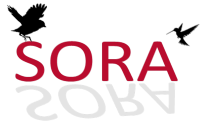Black-chinned Hummingbird sugar water consumption rates at four ranches in the Edward's Plateau Ecoregion in Texas during 2005
Black-chinned Hummingbird sugar water consumption rates at four ranches in the Edward's Plateau Ecoregion in Texas during 2005.
BRENT ORTEGO, Texas Parks & Wild. Dept, Victoria, TX, and ROSS DAWKINS, Chem. Dept, Angelo State Univ., San Angelo, TX.
Black-chinned Hummingbird (BCHU) sugar water consumption were studied at four rural ranch banding sites in the Edward's Plateau during the 2005 breeding season. Dan Brown Ranch, Tom Green Co., was located at the edge of the S. Concho River floodplain in the western Edward's Plateau in a forested park-like yard with 19 48-oz hummingbird feeders. Due to livestock grazing and high white-tailed deer densities, there were few hummingbird nectar producing plants. In the southeastern Edward's Plateau, Bob and Sudie Burditt Ranch, Real Co., was at the edge of the Frio River floodplain with park-like deciduous yard with 12 96-oz hummingbird feeders. Few hummingbird nectar producing plants were present for the same reasons as the Brown Ranch. Annie and Corky Matter Ranch, Kendall Co., was on top of a hill about 1/2 mi (0.8 km) from the small Flat Rock Creek in a cedar/hardwood savannah with 10 32-oz hummingbird feeders. Numerous hummingbird nectar plants were available in the residential yard of the banding site, but not in the rest of the ranch because of livestock and deer grazing. Egon and Sue Wiedenfeld Ranch, Kendall Co., was at the edge of the floodplain of Big Joshua Creek in a park-like hardwood setting with 10 32-oz hummingbird feeders. Many hummingbird nectar plants were available in the 10-acre (4 ha) residential yard as well as regular occurrence in the surrounding pastures because of lower livestock and deer numbers. 1850 BCHU were captured during visits once per month from April through June using modified Russell traps, and sugar water consumption was recorded daily and summed weekly. Banding was discontinued after June because of the beginning of migration. The Lincoln's Index was used to calculate hummingbird densities in May and June (80 recaptures from birds previously banded) and compared to sugar water consumption for the week of the banding. Sugar to water ratios of 1:4 was used at two ranches, and 1:5 and 1:3 at other ranches. All sugar water consumption was converted to 1 4 equivalents because this is the rate used at most hummingbird feeders. Sugar water consumption at each ranch is graphed below in gallons consumed per week. Sugar consumption typically started increasing in late March as migrants arrived, reached a peak in late April and then started declining in May, except the Brown Ranch with the larger hummingbird population did not peak out in sugar consumption until July. BCHU estimates per site varied from a low of 1542 at the Matter Ranch to 6350 at the Brown Ranch. Highest consumption rate by hummingbirds was at the Burditt ranch and lowest at the Matter Ranch. Availability of nectar- producing plants and suitable insect prey are suspected to influence consumption rates, but data from this study are not conclusive.
| Table 1. Sugar Water Consumption and the Lincoln's Index BCHU Estimated Population | ||
|---|---|---|
| Site | Lincoln's Index | Hummers/gall/d |
| Brown | 6350 | 1411 |
| Burditt | 2251 | 855 |
| Wiedenfeld | 2016 | 1275 |
| Matter | 1542 | 1610 |

